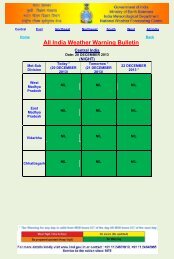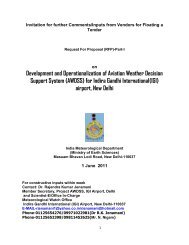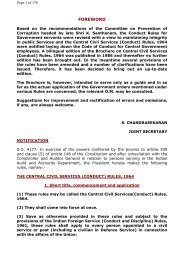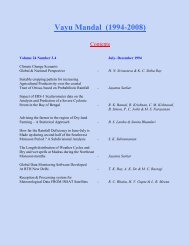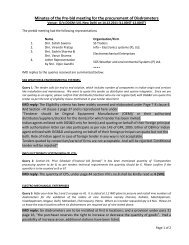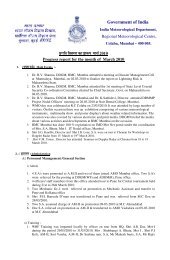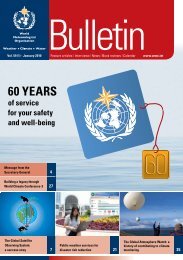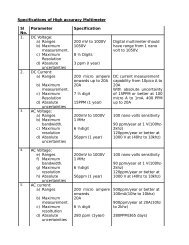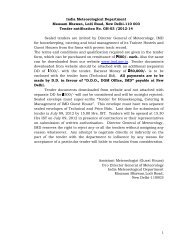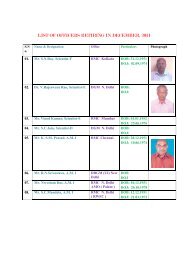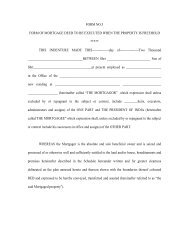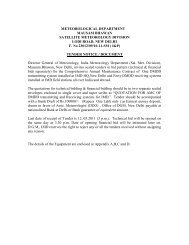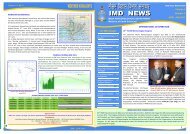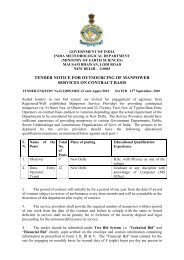[pdf]Climate profile of India - India Meteorological Department
[pdf]Climate profile of India - India Meteorological Department
[pdf]Climate profile of India - India Meteorological Department
Create successful ePaper yourself
Turn your PDF publications into a flip-book with our unique Google optimized e-Paper software.
The eastern coastal regions <strong>of</strong> <strong>India</strong>, viz., Tamil Nadu (TN), Andhra Pradesh<br />
(AP), Orissa and West Bengal (WB) are highly vulnerable to TC landfall whereas the<br />
western coastal regions <strong>of</strong> Kerala, Karnataka and Konkan & Goa are rarely affected<br />
by TC landfall. However, the state <strong>of</strong> Gujarat is affected by TC landfall. Further,<br />
Bangladesh, Arakan and Sri Lankan coasts are also greatly affected by landfalling<br />
TCs. It may be mentioned here that the TCs that crossed the TN and AP coasts<br />
were predominantly during the post-monsoon season and Orissa is mainly affected<br />
by TCs that form during the monsoon season. Fig. 27 (i-vii) a&b present the trends in<br />
the frequency <strong>of</strong> TC landfall over TN, AP, Orissa, WB, Bangladesh, Arakan and<br />
Gujarat coasts as CS+SCS / SCS. Here, those CS and SCS that retained their<br />
respective intensities at the time <strong>of</strong> coastal crossing are only considered for this<br />
analysis. Fig. 27(i-vii) c depicts the frequency <strong>of</strong> SCS to total cyclones that crossed<br />
these coasts.<br />
The decreasing trend in the frequency <strong>of</strong> cyclones crossing Orissa and<br />
Arakan coasts and a slight increasing trend in the frequency <strong>of</strong> severe cyclones<br />
crossing Bangladesh and Gujarat coasts were observed. There is also an increasing<br />
trend in the frequency <strong>of</strong> CS intensifying into SCS and crossing TN, Orissa,<br />
Bangladesh, Arakan and Gujarat coasts.<br />
6.3.4 Trends in the frequency <strong>of</strong> TCs dissipating over sea without making<br />
landfall<br />
No trends in the frequency <strong>of</strong> TCs (CS+SCS / SCS) forming over NIO<br />
dissipating over BOB and AS without making any landfall were observed during<br />
1900-2009 (Fig 28 a-d).<br />
6.4 Storm Surge<br />
Storm surge is the abnormal rise <strong>of</strong> sea level which occurs when the cyclone<br />
moves from ocean to continent. It is a disastrous and destructive feature <strong>of</strong> cyclone,<br />
which could cause massive destruction in the coastal region and misery to the<br />
coastal human population and livestock. Vulnerability in terms <strong>of</strong> the height <strong>of</strong> storm<br />
68


![[pdf]Climate profile of India - India Meteorological Department](https://img.yumpu.com/30766514/74/500x640/pdfclimate-profile-of-india-india-meteorological-department.jpg)
